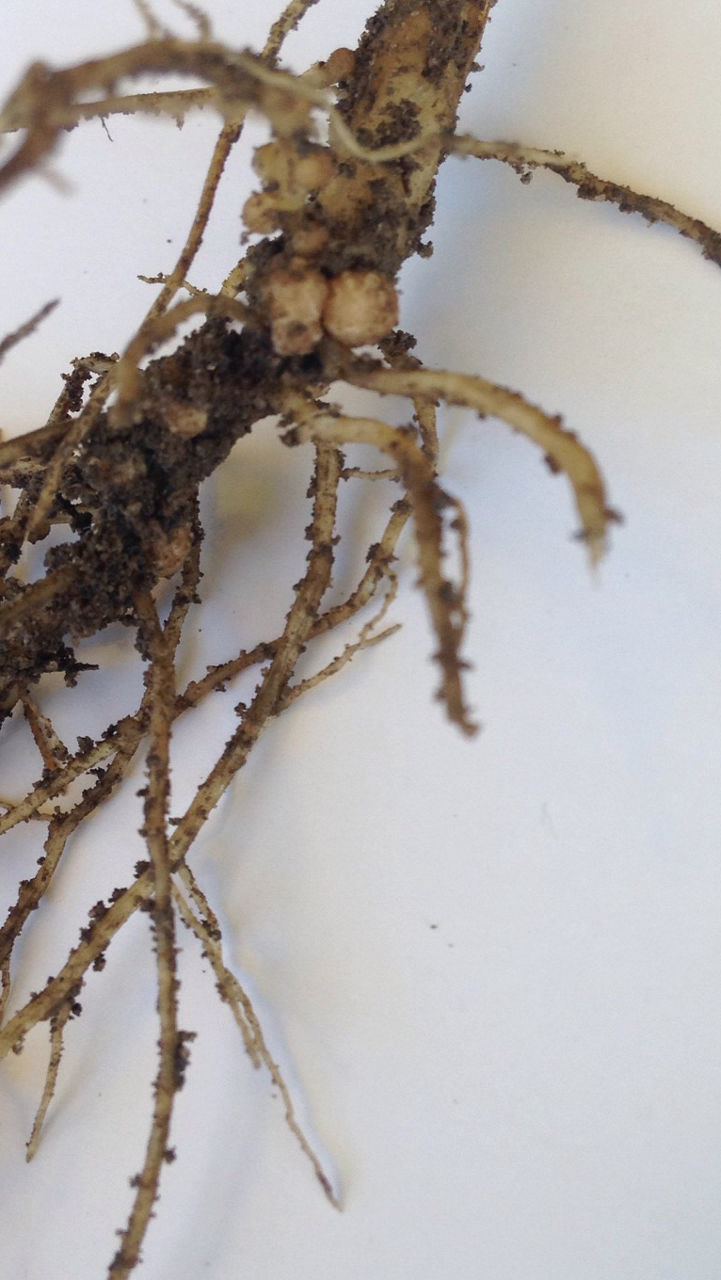Do You Know Brady Rhizobium?
February 21, 2024
Soybeans require a significant amount of nitrogen (N) to produce an average to high yielding crop. Studies show the above ground portion of a soybean plant (including grain) requires between 4.7 to 5.5 lb N/bu.1,3 A 50 bu crop on average needs 255 lbs of N and a 70 bu crop would need 360 lbs of N. The N comes largely from two sources, soil solution and N fixation from rhizobia bacteria (Bradyrhizobium japonicum) in the soil that are instrumental in soybean nodule formation (Figure 1). Nitrogen fixation rates can vary widely from 36% to 74% depending on the environment.2 Generally, N fixation provides half of the N and the soil provides the other half. Under ideal conditions, N fixation should max out around 300 lbs/acre.3

Doing the math and quickly your mind goes to the question, “Are we limiting yield because the plants are short on Nitrogen?” The quick answer is no, but it is more complicated than that. Many trials have been conducted by universities to study the effects of adding supplemental N to a soybean crop. There have been positive responses; however, there is usually no economic response unless there are special circumstances.
Situations where added fertilizer N or inoculation may help.
- Low bacteria populations from not raising a soybean crop in a field for several years may limit fixation. In this situation, it is best to inoculate soybean seed at planting to refresh the rhizobia strains and populations in the soil.
- Coarse textured soils may be unable to provide enough residual N in the soil solution. In-season supplemental N may be needed to help maximize yield potential. Coarse textured soils can also cause reduced nodulation.
- Flooded soils can result in death of the rhizobia thus limiting nodulation and cause denitrification. Both can reduce N availability later in the season when the plant needs it most.
- Soil pH <5.5 or >7.3 can reduce nodulation and depending on the nitrate availability in the soil, soybean plants could benefit from added N.
Another complication is that preplant or early season N applications reduce nodulation and/or fixation rates. In the presence of higher nitrate levels, the plant communicates with the rhizobia that it has enough N, effectively reducing nodulation and/or fixation rates.
The bottom line is that in most situations native and/or introduced strains of rhizobia along with soil solution N provide enough N to sustain soybean production. In high yield situations, if there are limiting factors for soil N availability or reduction in nodulation, there may be an opportunity to add economically beneficial yield by adding N in season. Research would suggest this is more the exception than the rule.
For additional information, please read Factors Influencing Soybean Nodulation.
Tony Weis
Channel Agronomist
Sources:
1Nutrient requirements – soybean. Integrated Crop Management. Iowa State University Extension and Outreach. https://crops.extension.iastate.edu/encyclopedia/nutrient-requirements-soybean.
2Ruark, M. Nitrogen and soybeans. 2009 Area Soil, Water, and Nutrient Management Meetings. University of Wisconsin-Extension. https://soilsextension.webhosting.cals.wisc.edu/wp-content/uploads/sites/68/2014/02/Nitrogen_And_Soybeans_Ruark.pdf.
3Shober, A.L. and Taylor, R. 2014. Nitrogen management for soybeans. https://www.udel.edu/academics/colleges/canr/cooperative-extension/fact-sheets/nitrogen-management-soybeans/#:~:text=Maximum%20N2%20fixation%20potential,nitrate%20(NO3%2D).
Other sources:
Kaiser, D., Fernandez, F., Wilson, M. and Piotrowski, K. 2023. Fertilizing soybean in Minnesota. Nutrient Management. Soybean. University of Minnesota Extension. https://extension.umn.edu/crop-specific-needs/soybean-fertilizer-guidelines#phosphate-and-potash-1078561.
Clay, D.E. and Gustafson, K. 2019. Chapter 24: N fixation problems and in-season N applications. iGrow Soybean. South Dakota State University Extension. https://extension.sdstate.edu/sites/default/files/2020-03/S-0004-24-Soybean.pdf.
McDermott, T.R., Graham, P.H., and Ferrey, M.L. 1991. Competitiveness of indigenous populations of Bradyrhizobium japonicum serocluster 123 as determined using a root-tip marking procedure in growth pouches. Plant and Soil Science. https://link.springer.com/article/10.1007/BF00010912
Web sources verified 12/26/23. 1110_349103
Seed Brands & Traits
Crop Protection
Disclaimer
Always read and follow pesticide label directions, insect resistance management requirements (where applicable), and grain marketing and all other stewardship practices.
©2024 Bayer Group. All rights reserved.